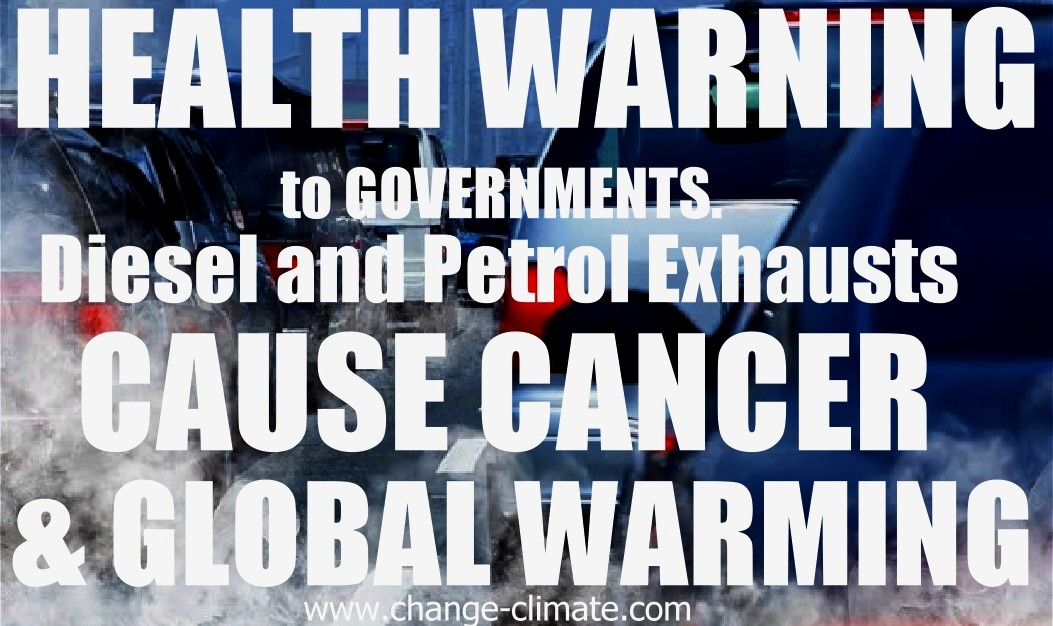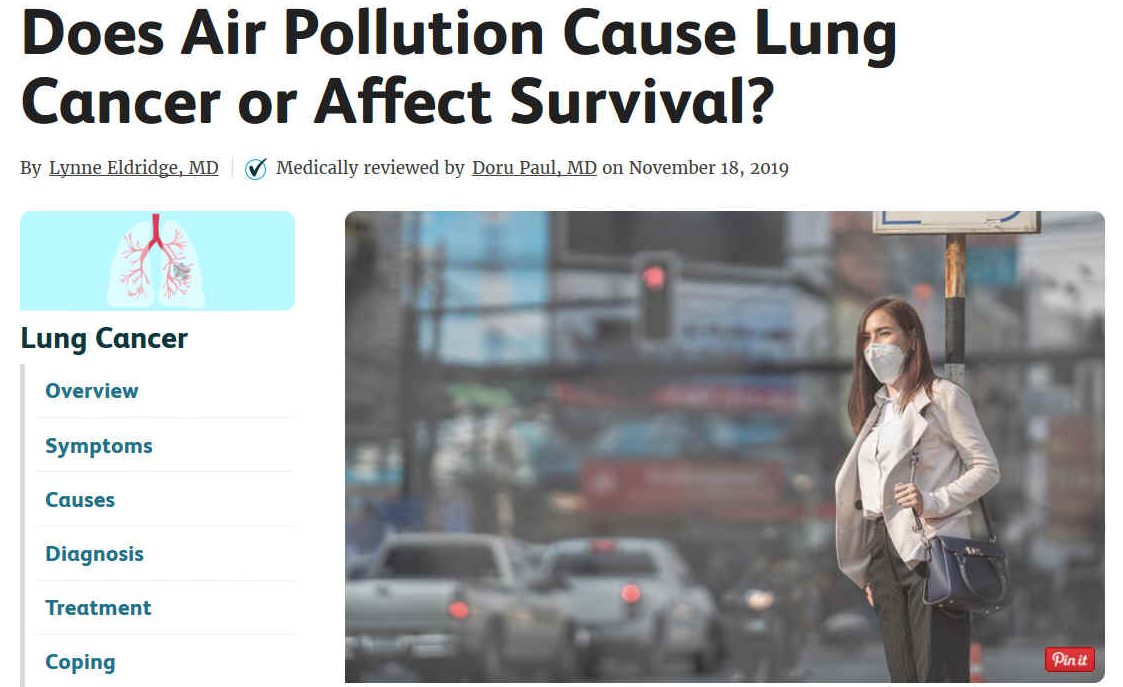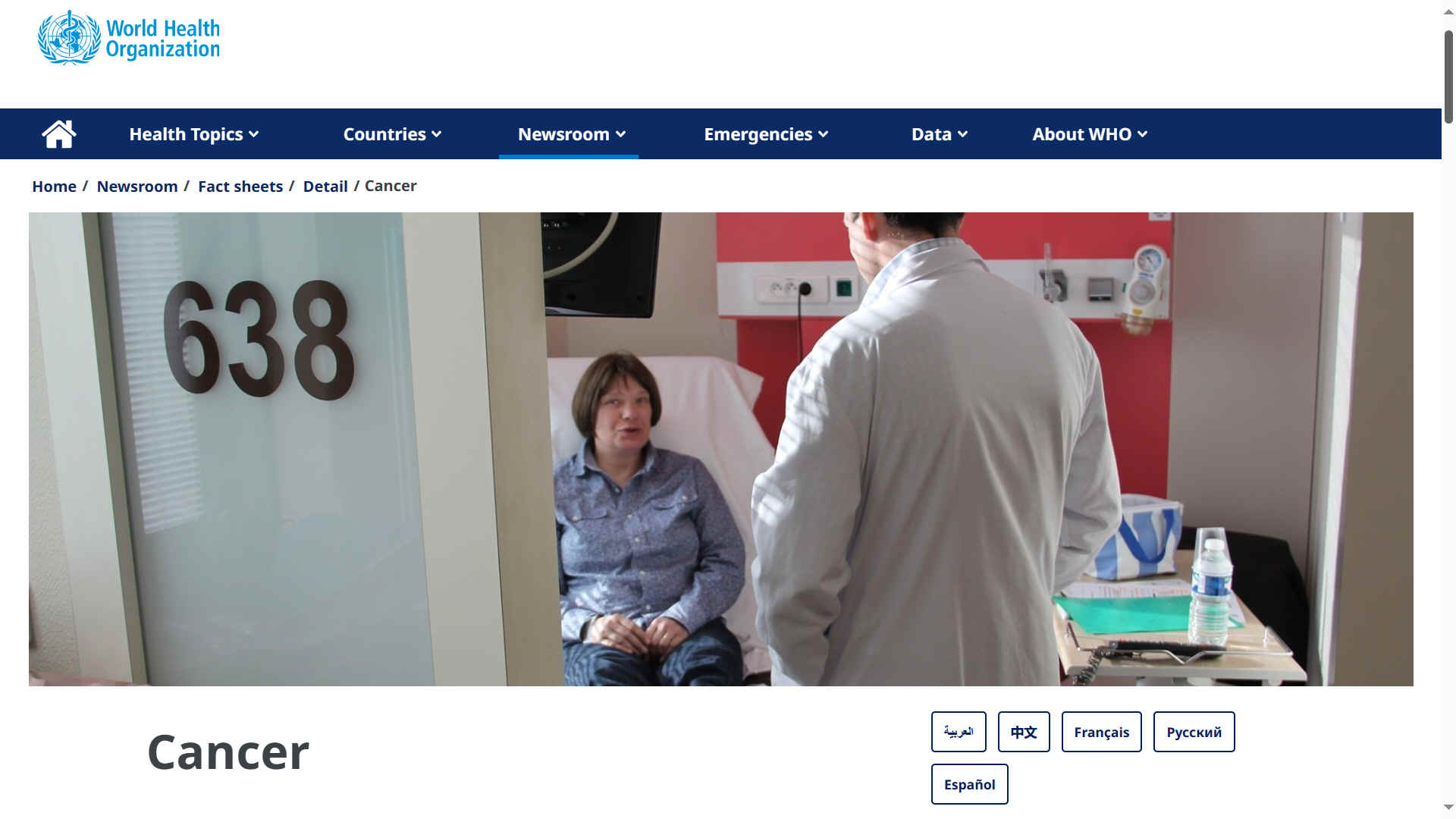|
A
- Z CANCER INDEX
Please use our
A-Z
INDEX to navigate this
site where pages may link to other sites or crawl HOME

EXHAUST
PIPES -
The fumes from car exhausts kills us slowly when we burn
it and release the carcinogens into the atmosphere to create
smogs. We might as well be smoking cigarettes. But there is no
Government health warning on car exhausts, plastic packaging
or oil wells. As many a tar soaked animal might attest!
A
Anal Cancer
B
Bladder Cancer
Bone Cancer
Brain Tumors
Breast Cancer
Bronchial Tumors (Lung Cancer)
C
Cardiac (Heart) Tumors, Childhood
Cervical Cancer
Colon
Cancer
D
Ductal Carcinoma In Situ (DCIS) - see Breast Cancer
E
Esophageal
(throat cancer)
Eye Cancer
F
Fallopian Tube Cancer
G
Gallbladder Cancer
Gastric (Stomach) Cancer
Gastrointestinal Carcinoid Tumor
Gestational Trophoblastic Disease
H
Heart Tumors, Childhood
Hodgkin Lymphoma

I
Intraocular Melanoma
Islet Cell Tumors, Pancreatic Neuroendocrine Tumors
K
Kidney (Renal Cell) Cancer
L
Leukemia
Liver Cancer
Lung
Cancer (Non-Small Cell, Small Cell, Pleuropulmonary Blastoma, and Tracheobronchial Tumor)
Lymphoma
M
Melanoma
N
Nasal Cavity and Paranasal Sinus Cancer (Head and Neck Cancer)
Nasopharyngeal Cancer (Head and Neck Cancer)
O
Oral Cancer, Lip and Oral Cavity Cancer and Oropharyngeal Cancer (Head and Neck Cancer)
Ovarian Cancer
P
Pancreatic Cancer
Penile Cancer
Prostate Cancer
R
Rectal Cancer
Renal Cell (Kidney) Cancer
Research
- Harriet
Flood, Jill
Finn, Matthew
Flood
S
Skin Cancer
Stomach (Gastric) Cancer
T
Testicular Cancer
Throat Cancer (Head and Neck Cancer)
Thyroid Cancer
U
Urethral Cancer
V
Vaginal Cancer
Vulvar Cancer
W
Y
Remember Hinkley,
California and PG&E.

Air pollution levels tend to be higher in UK towns and cities.
So why would anyone live there? The answer to that is they
need the work and the money - so are prepared to accept the
risk of a shorter life and painful death. And of course it
costs more to live in the country, where there are no
affordable houses. Councils like Wealden
make sure of that, by only building executive housing, then
complaining about the cost of temporary housing for the
homeless. It is of course their policies that are nuts.
Councils not building low cost housing should be
disenfranchised. Returning control to the State, who should
only allow self-builds and flat-pack homes. Other councils
misbehaving should be subject to rate caps, for not providing
the services they are claiming to provide. Administrative and
executive staff should be reduced by at least 50% with no
enhanced pensions. AI should be considered for routine admin,
to reduce costs further, in the interests of reducing
financial slavery.
In 2013, the International Agency for Research on Cancer (IARC) confirmed that outdoor air pollution is a cause of
cancer. Tiny dust-like particles just millionths of a metre wide, called ‘particulate matter’, make up a part of outdoor air pollution. The smallest particles known as PM10 and PM2.5 are linked to lung cancers caused by pollution. It is not fully understood how these particles can damage
DNA in cells and cause cancer.
The dread and fear that can come with a cancer diagnosis have their roots in its killer nature: It's the No. 2 cause of death in Americans, second only to heart disease, according to the Centers for Disease Control and Prevention. Even when diagnosed early and attacked with the latest treatments, it still has the power to kill.
To help raise money to find cures and treatments for cancer patients, the "Stand Up to Cancer" telethon
aired on ABC, NBC and CBS and other networks and cable stations starting
in September 2010. The telethon feature a host of celebrity guests, including George Clooney, Denzel Washington, Renee Zellweger and Will Smith.
"'Stand Up To Cancer' represents collaborative efforts" to provide funding for cancer research, Dr. Len Lichtenfeld, deputy chief medical officer of the American Cancer Society,
is quoted as saying.
"We would not be where we are if basic and clinical science wasn't funded," Lichtenfeld said. "Basic science teaches us about mechanisms, about how drugs may be effective, and we take that info and put it into a clinic to find out whether or not those new ideas work in cancer treatment."
While there are many successful treatments today that didn't exist just a couple decades ago, a wholesale "cure for cancer " remains elusive for many reasons. There are more than 100 types of cancer, characterized by abnormal cell growth. There are many different causes, ranging from
radiation to chemicals to viruses; an individual has varying degrees of control over exposure to cancer-causing agents.
Cancer cells, and how they grow, remain unpredictable and in some cases mysterious. Even after seemingly effective treatments, crafty cancer cells are able to hide out in some patients and resurface.
In 2010, about $200 billion had been spent on cancer research since the early 1970s, and the five-year survival rate for all people diagnosed with cancer in the U.S. has risen from about 50 percent in the 1970s to 65 percent.
Using the links above, you can take a look at the 10 cancers that killed the most people in the United States between 2003 and 2007, from data available, according to the National Cancer Institute (NCI).
THE
UNSEEN WARD: A TALE OF ACCIDENTAL ALCHEMY
Agnes Thistlewick wasn't a witch. At least, that's what she kept telling herself. Potions simmered on her stove more out of habit than intention, and her muttering under her breath was usually directed at the rogue tomato that dared to roll off the counter. Yet, something strange surrounded Agnes, a shield she hadn't built and a power she didn't understand.
Lord Blackwood, the local baron, was no stranger to cruelty. He'd squeezed rents from his tenants until their pockets bled dry, evicted families on a whim, and poisoned the well of dissent with fear. But when he set his sights on Agnes' cozy cottage, a curious thing happened. Every attempt to evict her backfired spectacularly. A rainstorm flooded the eviction notice, a runaway cart flattened the bailiff's summons, and a swarm of bees chased the tax collector from Agnes' doorstep.
Meanwhile, Agnes herself seemed impervious. Each thwarted attempt left Lord Blackwood
spluttering with rage, his face growing a shade paler each time. The villagers, initially skeptical, started whispering. Agnes, they said, possessed a "hedge witch's blessing," a subconscious ward woven from her unwavering spirit.
Across the rolling hills, a similar story unfolded. Mayor Grimshaw, notorious for shady land deals and silencing dissent, found himself thwarted at every turn. Petitions against his latest scheme spontaneously combusted in his office, his accusations against outspoken citizens dissolved into incoherent mumbles, and the ground inexplicably swallowed his prized attack dog whole.
The villagers, Amelia in particular, who had faced Grimshaw's wrath firsthand, started noticing a change in themselves. With every failed attempt, they felt a surge of defiance, a newfound resilience. It was as if the mayor's malice, deflected by some unseen force, somehow enriched their determination.
One blustery evening, a group of villagers huddled around Agnes' crackling hearth. The topic, as always, was the escalating oddity. Agnes, flustered by the attention, confessed her lack of magical prowess.
"It's just... I can't stand bullies," she mumbled, stirring her chamomile tea. "And when I think about them, bad things seem to happen."
A wizened old farmer named Thomas chuckled. "Maybe, lass, that's all it takes. A strong enough will, a heart full of righteousness, can weave magic without even knowing it."
The idea resonated. Perhaps Agnes wasn't a witch, but her unwavering spirit, her refusal to be cowed, had created an unintended field of protection – a force field of sheer righteousness. As negativity bounced off them, the villagers, too, were somehow strengthened.
News of the "unseen ward" spread. People started believing in themselves, their voices gaining strength.
Lord Blackwood and Mayor Grimshaw, on the other hand, grew increasingly haggard. Their attempts at oppression became self-defeating spectacles, their power draining away like a deflating balloon.
In the end, it wasn't spells or potions that brought them down. It was the weight of their own malice, the villagers' unwavering resistance, and a collective belief that good, even in its most mundane form, can be a powerful weapon. Agnes Thistlewick, the accidental witch, had shown them all that the truest magic lay in the unyielding human spirit.

WORLD HEALTH ORGANIZATION 2 FEBRUARY 2022: CANCER - NUMBER ONE CAUSE OF DEATHS
KEY FACTS
- Cancer is a leading cause of death worldwide, accounting for nearly 10 million deaths in 2020, or nearly one in six deaths.
- The most common cancers are breast, lung, colon and rectum and prostate cancers.
- Around one-third of deaths from cancer are due to tobacco use, high body mass index, alcohol consumption, low fruit and vegetable intake, and lack of physical activity.
- Cancer-causing infections, such as human papillomavirus (HPV) and hepatitis, are responsible for approximately 30% of cancer cases in low- and lower-middle-income countries.
- Many cancers can be cured if detected early and treated effectively.
OVERVIEW
Cancer is a generic term for a large group of diseases that can affect any part of the body. Other terms used are malignant tumours and neoplasms. One defining feature of cancer is the rapid creation of abnormal cells that grow beyond their usual boundaries, and which can then invade adjoining parts of the body and spread to other organs; the latter process is referred to as metastasis. Widespread metastases are the primary cause of death from cancer.
THE PROBLEM
Cancer is a leading cause of death worldwide, accounting for nearly 10 million deaths in 2020 (1). The most common in 2020 (in terms of new cases of cancer) were:
- breast (2.26 million cases);
- lung (2.21 million cases);
- colon and rectum (1.93 million cases);
- prostate (1.41 million cases);
- skin (non-melanoma) (1.20 million cases); and
- stomach (1.09 million cases).
The most common causes of cancer death in 2020 were:
- lung (1.80 million deaths);
- colon and rectum (916 000 deaths);
- liver (830 000 deaths);
- stomach (769 000 deaths); and
- breast (685 000 deaths).
Each year, approximately 400 000 children develop cancer. The most common cancers vary between countries. Cervical cancer is the most common in 23 countries.
CAUSES
Cancer arises from the transformation of normal cells into tumour cells in a multi-stage process that generally progresses from a pre-cancerous lesion to a malignant tumour. These changes are the result of the interaction between a person's genetic factors and three categories of external agents, including:
- physical carcinogens, such as ultraviolet and ionizing radiation;
- chemical carcinogens, such as asbestos, components of tobacco smoke, alcohol, aflatoxin (a food contaminant), and arsenic (a drinking water contaminant); and
- biological carcinogens, such as infections from certain viruses, bacteria, or parasites.
WHO, through its cancer research agency, the International Agency for Research on Cancer (IARC), maintains a classification of cancer-causing agents.
The incidence of cancer rises dramatically with age, most likely due to a build-up of risks for specific cancers that increase with age. The overall risk accumulation is combined with the tendency for cellular repair mechanisms to be less effective as a person grows older.
RISK FACTORS
Tobacco use, alcohol consumption, unhealthy diet, physical inactivity and
air pollution are risk factors for cancer and other
non-communicable diseases.
Some chronic infections are risk factors for cancer; this is a particular issue in low- and middle-income countries. Approximately 13% of cancers diagnosed in 2018 globally were attributed to
carcinogenic infections, including Helicobacter pylori, human papillomavirus (HPV), hepatitis B virus, hepatitis C virus, and Epstein-Barr virus (2).
Hepatitis B and C viruses and some types of HPV increase the risk for liver and cervical cancer, respectively. Infection with HIV increases the risk of developing cervical cancer six-fold and substantially increases the risk of developing select other cancers such as Kaposi sarcoma.
REDUCING THE BURDEN
Between 30 and 50% of cancers can currently be prevented by avoiding risk factors and implementing existing evidence-based prevention strategies. The cancer burden can also be reduced through early detection of cancer and appropriate treatment and care of patients who develop cancer. Many cancers have a high chance of cure if diagnosed early and treated appropriately.
PREVENTION
Cancer risk can be reduced by:
- not using tobacco;
- maintaining a healthy body weight;
- eating a healthy diet, including fruit and vegetables;
- doing physical activity on a regular basis;
- avoiding or reducing consumption of alcohol;
- getting vaccinated against HPV and hepatitis B if you belong to a group for which vaccination is recommended;
- avoiding ultraviolet radiation exposure (which primarily results from exposure to the sun and artificial tanning devices) and/or using sun protection measures;
- ensuring safe and appropriate use of radiation in health care (for diagnostic and therapeutic purposes);
- minimizing occupational exposure to ionizing radiation; and
- reducing exposure to outdoor air pollution and indoor air pollution, including radon (a radioactive gas produced from the natural decay of
uranium, which can accumulate in buildings — homes, schools and workplaces).
EARLY DETECTION
Cancer mortality is reduced when cases are detected and treated early. There are two components of early detection: early diagnosis and screening.
EARLY DIAGNOSIS
When identified early, cancer is more likely to respond to treatment and can result in a greater probability of survival with less morbidity, as well as less expensive treatment. Significant improvements can be made in the lives of cancer patients by detecting cancer early and avoiding delays in care.
Early diagnosis consists of three components:
- being aware of the symptoms of different forms of cancer and of the importance of seeking medical advice when abnormal findings are observed;
- access to clinical evaluation and diagnostic services; and
- timely referral to treatment services.
Early diagnosis of symptomatic cancers is relevant in all settings and the majority of cancers. Cancer programmes should be designed to reduce delays in, and barriers to, diagnosis, treatment and supportive care.
SCREENING
Screening aims to identify individuals with findings suggestive of a specific cancer or pre-cancer before they have developed symptoms. When abnormalities are identified during screening, further tests to establish a definitive diagnosis should follow, as should referral for treatment if cancer is proven to be present.
Screening programmes are effective for some but not all cancer types and in general are far more complex and resource-intensive than early diagnosis as they require special equipment and dedicated personnel. Even when screening programmes are established, early diagnosis programmes are still necessary to identify those cancer cases occurring in people who do not meet the age or risk factor criteria for screening.
Patient selection for screening programmes is based on age and risk factors to avoid excessive false positive studies. Examples of screening methods are:
- HPV test (including HPV DNA and mRNA test), as preferred modality for cervical cancer screening; and
- mammography screening for breast cancer for women aged 50–69 residing in settings with strong or relatively strong health systems.
Quality assurance is required for both screening and early diagnosis programmes.
TREATMENT
A correct cancer diagnosis is essential for appropriate and effective treatment because every cancer type requires a specific treatment regimen. Treatment usually includes surgery, radiotherapy, and/or systemic therapy (chemotherapy, hormonal treatments, targeted biological therapies). Proper selection of a treatment regimen takes into consideration both the cancer and the individual being treated. Completion of the treatment protocol in a defined period of time is important to achieve the predicted therapeutic result.
Determining the goals of treatment is an important first step. The primary goal is generally to cure cancer or to considerably prolong life. Improving the patient's quality of life is also an important goal. This can be achieved by support for the patient’s physical, psychosocial and spiritual well-being and palliative care in terminal stages of cancer.
Some of the most common cancer types, such as breast cancer, cervical cancer, oral cancer, and colorectal cancer, have high cure probabilities when detected early and treated according to best practices.
Some cancer types, such as testicular seminoma and different types of leukaemia and lymphoma in children, also have high cure rates if appropriate treatment is provided, even when cancerous cells are present in other areas of the body.
There is, however, a significant variation in treatment availability between countries of different income levels; comprehensive treatment is reportedly available in more than 90% of high-income countries but less than 15% of low-income countries (3).
PALLIATIVE CARE
Palliative care is treatment to relieve, rather than cure, symptoms and suffering caused by cancer and to improve the quality of life of patients and their families. Palliative care can help people live more comfortably. It is particularly needed in places with a high proportion of patients in advanced stages of cancer where there is little chance of cure.
Relief from physical, psychosocial, and spiritual problems through palliative care is possible for more than 90% of patients with advanced stages of cancer.
Effective public health strategies, comprising community- and home-based care, are essential to provide pain relief and palliative care for patients and their families.
Improved access to oral morphine is strongly recommended for the treatment of moderate to severe cancer pain, suffered by over 80% of people with cancer in the terminal phase.
WHO RESPONSE
In 2017, the World Health Assembly passed the Resolution Cancer prevention and control in the context of an integrated approach (WHA70.12) that urges governments and WHO to accelerate action to achieve the targets specified in the Global Action Plan for the prevention and control of NCDs 2013-2020 and the 2030
UN Agenda for
Sustainable Development to reduce premature mortality from cancer.
WHO and IARC collaborate with other UN organizations, inlcuing the International Atomic Energy Agency, and partners to:
- increase political commitment for cancer prevention and control;
- coordinate and conduct research on the causes of human cancer and the mechanisms of carcinogenesis;
- monitor the cancer burden (as part of the work of the Global Initiative on Cancer Registries);
-
identify “best buys” and other cost-effective, priority strategies for cancer prevention and control;
-
develop standards and tools to guide the planning and implementation of interventions for prevention, early diagnosis, screening, treatment and palliative and survivorship care for both adult and child cancers;
- strengthen health systems at national and local levels to help them improve access to cancer treatments;
set the agenda for cancer prevention and control in the 2020 WHO Report on Cancer;
-
provide global leadership as well as technical assistance to support governments and their partners build and sustain high-quality cervical cancer control programmes as part of the Global Strategy to Accelerate the Elimination of Cervical Cancer;
- improve breast cancer control and reduce avoidable deaths from breast cancer, focusing on health promotion, timely diagnosis and access to care in order to accelerate coordinated implementation through the WHO Global Breast Cancer Initiative;
- support governments to improve survival for childhood cancer through directed country support, regional networks and global action as part of the WHO Global Initiative for Childhood Cancer using the CureAll approach;
- increase access to essential cancer medicines, particularly through the Global Platform for Access to Childhood Cancer Medicines; and
- provide technical assistance for rapid, effective transfer of best practice interventions to countries.
REFERENCES
(1) Ferlay J, Ervik M, Lam F, Colombet M, Mery L, Piñeros M, et al. Global Cancer Observatory: Cancer Today. Lyon: International Agency for Research on Cancer; 2020 (https://gco.iarc.fr/today, accessed February 2021).
(2) de Martel C, Georges D, Bray F, Ferlay J, Clifford GM. Global burden of cancer attributable to infections in 2018: a worldwide incidence analysis. Lancet Glob Health. 2020;8(2):e180-e190.
(3) Assessing national capacity for the prevention and control of noncommunicable diseases: report of the 2019 global survey. Geneva: World Health Organization; 2020.
LINKS
& REFERENCE
https://www.cancer.gov/types
https://cancerstatisticscenter.cancer.org/#!/state/California
https://www.lung.org/about-us/blog/2016/06/lung-cancer-and-pollution.html
https://doctor.ndtv.com/cancer/world-cancer-day-can-air-pollution-be-linked-to-cancer-our-expert-tells-2171604
https://www.thoughtco.com/what-is-smog-3444125
https://www.verywellhealth.com/air-pollution-and-lung-cancer-2249413
https://airnow.gov/
https://www.cancerresearchuk.org/about-cancer/causes-of-cancer/air-pollution-radon-gas-and-cancer/how-can-air-pollution-cause-cancer
https://www.who.int/news-room/fact-sheets/detail/cancer
https://www.who.int/news-room/fact-sheets/detail/cancer
https://www.cancer.gov/types
https://cancerstatisticscenter.cancer.org/#!/state/California
https://www.lung.org/about-us/blog/2016/06/lung-cancer-and-pollution.html
https://doctor.ndtv.com/cancer/world-cancer-day-can-air-pollution-be-linked-to-cancer-our-expert-tells-2171604
https://www.thoughtco.com/what-is-smog-3444125
https://www.verywellhealth.com/air-pollution-and-lung-cancer-2249413
https://airnow.gov/
https://www.cancerresearchuk.org/about-cancer/causes-of-cancer/air-pollution-radon-gas-and-cancer/how-can-air-pollution-cause-cancer

This
website is provided on a free basis as a public information service.
copyright © Injustice Alliance 2024. Solar
Studios, BN271RF, United Kingdom.
|




